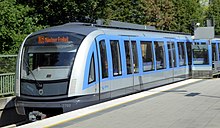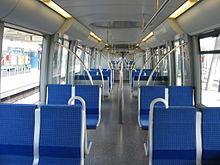MVG series C
| Munich subway series C |
|
|---|---|
| Number: | C1: 18 multiple units (108 single wagons) C2: 21 (+46) multiple units (126 (+276) single wagons) |
| Manufacturer: | C1: Adtranz , Siemens C2: Siemens |
| Year of construction (s): | from 2000 |
| Axis formula : | Bo'Bo '+ Bo'Bo' + Bo'Bo '+ Bo'Bo' + Bo'Bo '+ Bo'Bo' |
| Gauge : | 1435 mm ( standard gauge ) |
| Length over coupling: | C1: 114,820 mm C2: 115,000 mm |
| Height: | 3,550 mm |
| Width: | 2,900 mm |
| Trunnion Distance: | 12,000 mm |
| Empty mass: | C1: 164 t C2: 182 t |
| Top speed: | C1: 80 km / h C2: 90 km / h (design) 80 km / h (operational) |
| Traction power: | C1: 24 × 100 kW = 2400 kW
C2: 24 × 140 kW = 3360 kW |
| Driving wheel diameter: | 850 mm (new) |
| Power system : | 750 V DC |
| Power transmission: | Lateral power rail coated from below |
| Number of traction motors: | 24 three-phase asynchronous motors |
| Brake: | Electric brake (regenerative brake with energy recovery), mechanical disc brake with pneumatic actuation, spring-loaded brake |
| Coupling type: | Scharfenberg coupling |
| Seats: | C1: 252 C2: 220 |
| Standing room: | C1: 660 C2: 720 |
The C series is currently the youngest generation of vehicles in use on the Munich subway . The vehicles built from 2000 onwards deviate from the previous principle of the double railcar and form a single unit for the first time. As a result, the train can be seen from anywhere, which, in addition to the increased space, should also give a feeling of subjective security. Since 2014, further vehicles have been supplied under the designation C2, which correspond to the basic concept of the C1 series.
Development and procurement
| Type | Numbers | Years of construction |
|---|---|---|
| C1.9 | 601-610 | 2000-2001 |
| C1.10 | 611-618 | 2005 |
| C2.11 | 701-721 | 2013-2015 |
| C2.12 | 722-745 | since 2019 |
C1
As in Berlin, the first question that arose in Munich in 1997 was whether a three- or six-car train should represent the next generation of vehicles. Finally, the decision was made for a continuous long train. Adtranz was chosen as the manufacturer for the vehicle construction and Siemens for the electrical part.
The new cars differ fundamentally from their predecessors, not only visually, but also in the fact that the vehicles can be walked through. The lack of a central driver's cab increases the capacity and the trains are cheaper. However, the length of the vehicles can no longer be adapted to the respective traffic volume, shortening / lengthening is only possible in the workshop. Therefore, they are used almost without exception on lines on which long trains run.
The transition option offers passengers the opportunity to distribute themselves within the entire train. Furthermore, the transition option increases the safety of the passengers, since in an emergency you can go through the whole train to the driver's cab. If the number of people is weak, the driver can not only look through the entire train via video, but also directly.
The 610 car bears the Garching city arms, as it was financed by the city of Garching for the extension of the U6 to the research center .
C2
On November 12, 2010, MVG announced the order for 21 new vehicles from Siemens. The investment volume is around 185 million euros. There were two options for a further 46 vehicles, which were converted into firm orders in 2016 and 2020, respectively.
The 21 firmly ordered trains (MVG series designation C2.11) were delivered between 2013 and 2015, but could not be used until mid-June 2016 because the government of Upper Bavaria has not yet issued the necessary operating license. 14 trains are replacing older old vehicles that have been retired and have been in service for over 40 years. 7 trains are required for the first part of the 2010-2020 MVG service offensive.
Outwardly and conceptually, the type C2 vehicles largely correspond to the type C1 used for the first time in 2002 (series C1.9 and C1.10, a total of 18 trains = 108 cars). The C2 shows the following changes compared to the C1:
- Enlarged standing areas in the transition areas between the cars, which is hoped for a better flow of passengers and higher capacity
- Upholstered seats throughout instead of wooden longitudinal seats
- Colored LED light strips in the door edges (for better visibility of the opening and closing process)
- Changed head shape
- Higher design speed: 90 km / h instead of the previous 80 km / h
- Higher output: 3360 kW instead of the previous 2400 kW
- Lower maintenance costs and improved diagnostic options for faster troubleshooting
- Equipped with video surveillance , passenger television and fire protection equipment ex works
- Pre-equipment for driverless operation (driver's cab could be omitted or reduced; this would result in higher capacity)
The C2 offers a total of 940 passengers - instead of the previous 912 for the C1. This corresponds to three percent more capacity, but this is based on the reduction in the number of seats and a corresponding increase in the number of standing places. Compared to long trains consisting of A and B cars, the new C train can accommodate eight percent more passengers due to the lack of four central driver's cabs.
In contrast to the C1, the mechanical part of the C2 is also built by Siemens in Munich-Allach and Vienna . The vehicle is technically based on the new Inspiro vehicle platform.

On June 17, 2016, train 702 received approval from TAB for a provisional use between Garching and Fröttmaning, which was expanded into a pine garden during the day. The C2 trains have been running on the entire U6 line since the end of 2016, and on the entire U3 line since June 14, 2018. In February 2018, 18 out of 21 trains were already registered, with an average of 11 in service every day.
A further 24 vehicles of type C2 (MVG series designation C2.12) have been delivered since 2019 after the 1st option has been triggered, the first vehicles of this series will be used by passengers on the U3 and U6 from May 7, 2020 after receiving approval. All 24 vehicles in this order will be delivered and put into operation by the beginning of 2022. The new vehicles differ only slightly from the existing 21 vehicles of type C2 (e.g. changed stickers or additional emergency call buttons at the wheelchair space).
In mid-2020, the second option was redeemed for 22 additional C2 trains. These are to be delivered between 2022 and 2024. The investment volume for this amounts to around 200 million euros.
Structure and technology
The structure of the C-cars is strongly reminiscent of the H-cars of the Berlin underground . Like this, the vehicle is all-axle driven and divided into six cars, two end cars and four middle cars. The car body of the vehicles was created in aluminum integral and differential construction and, as with the two predecessor types A and B , is 2.90 m wide. The entire train has a length of approx. 114 m, of which the head cars are 19.78 m and the middle cars 18.82 m long.
Due to problems with the axles, the 10 type C1.9 wagons had to be temporarily shut down between December 2006 and April 2007. After detailed investigations, however, the trains could be put back into operation.
design
The vehicle design was created by Alexander Neumeister . In addition to the generously glazed driver's cab windows, the implemented model also provides generous passages between the cars and special parking spaces for prams, wheelchair users and bicycles. The deeply drawn down side windows and the curved handrails inside the car are striking.
The design of the new C2 vehicles, which Alexander Neumeister helped to develop, received the Universal Design Award in February 2013 and the Red dot design award in July 2013 .
Seat offer
In the middle car there are alternating face-to-face seats with blue fabric upholstery and wooden longitudinal seats. The end cars are only equipped with longitudinal seats to provide more space. The entrance areas have padded standing aids and new, additional holding options. Compared to a type A and B long train, the C1 train offers around 5% more passengers.
There are no more wooden benches on the C2 train, only upholstered seats. (Source: MVG Münchner Verkehrsgesellschaft leaflet, August 2015, Article No. 114149)
Doors
The passenger change is faster than with the predecessors thanks to the wider doors. In addition, all doors can be opened from the driver's cab. If objects or people are trapped, the door will not close. However, the door can be closed immediately in the event of a willful blockage. The closing of the doors is announced by optical and acoustic signals.
Awards
The C2 series was awarded the Universal Design Consumer Favorite 2013 (awarded by consumers) and the Universal Design Award 2013 (awarded by experts) for its design
See also
- Munich U-Bahn # vehicles - Overview of the vehicles of the Munich U-Bahn
- BVG series H - comparable vehicle of the Berlin U-Bahn, also continuous over its entire length
- U-Bahn Vienna type V - comparable vehicle of the U-Bahn Vienna, also continuous over the entire length
literature
- Martin Pabst: U- and S-Bahn vehicles in Germany . 1st edition, GeraMond Verlag, Munich 2000, ISBN 3-932785-18-5
- Wolfgang Pischek, Holger Junghardt: The Munich U-Bahn - underground through the Bavarian capital . Munich 2002 (2nd edition), ISBN 3-7654-7194-1
Individual evidence
- ↑ a b MVG press release: Modernization boost for the Munich subway ( Memento from October 18, 2014 in the Internet Archive ) (PDF file; 131 kB)
- ↑ First Munich subway train C2 presented. Siemens Rail Systems, February 21, 2014, accessed June 15, 2017 .
- ↑ Frederik Buchleitner: U-Bahn: SWM orders another 22 C2 trains from Siemens. In: Tramreport.de. Retrieved on July 2, 2020 (German).
- ↑ Marco Völklein: MVG: Some wait, others start . In: sueddeutsche.de . ISSN 0174-4917 ( sueddeutsche.de [accessed on May 4, 2016]).
- ↑ Siemens delivers new subway for Munich , on siemens.com
- ↑ Frederik Buchleitner: U-Bahn: C2 passenger deployment to Großhadern. Tramreport, November 4, 2016, accessed on November 6, 2016 .
- ↑ Facebook page of the MVG. MVG, accessed on June 26, 2018 .
- ↑ Munich: MVG: All C2 trains have to get off the track: The U-Bahn disaster. Retrieved February 16, 2019 .
- ↑ Editorial office mvg.de: New subways for Munich: first C2 train ordered from Thursday in use. Retrieved May 6, 2020 .
- ↑ Editor mvg.de: Modernization push for the Munich subway: MVG receives 22 more metro trains of type C2. Retrieved July 2, 2020 .
- ^ Siemens AG (ed.): Excellent subway from Siemens: Munich C2 train receives design prize . Press release from July 2, 2013 (similar version as PDF file online ; PDF; 181 kB).
- ↑ Le nouveau métro de Munich remporte deux récompenses pour son design. Retrieved May 8, 2019 . (French)
Web links
- Florian Schütz: Vehicles of the Munich subway: Type C. In: u-bahn-muenchen.de , June 17, 2019.




